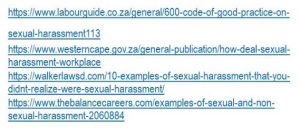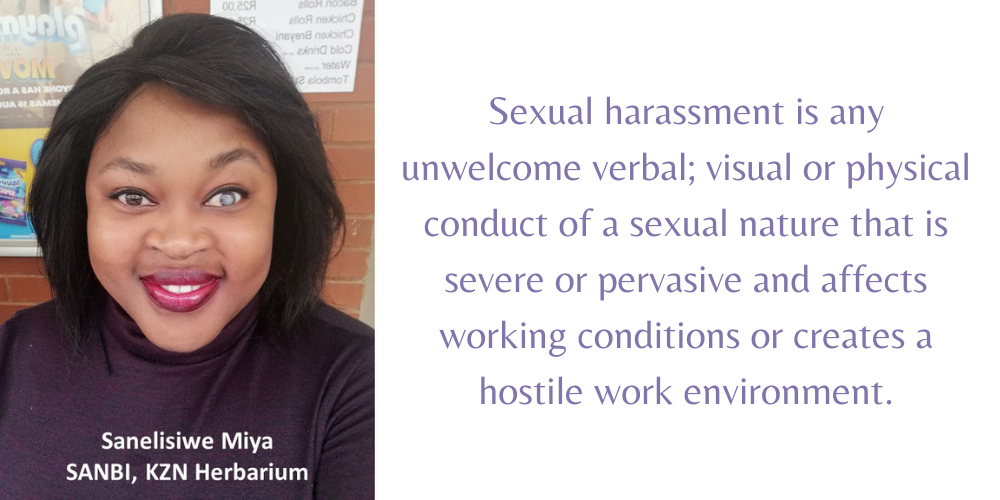Sanelisiwe Miya, SANBI KZN Herbarium
 VERBAL harassment includes:
VERBAL harassment includes:
- comments about clothing
- a person’s body
- sexual or gender-based jokes or remarks
- requesting sexual favours, or
- repeatedly asking a person out
- sexual innuendos
- threats
- spreading rumours about a person’s personal or sexual life, or
- using foul and obscene language
 PHYSICAL harassment often includes:
PHYSICAL harassment often includes:
- sexual assault
- impeding/blocking movement
- inappropriate touching, such as
- kissing
- hugging
- patting
- stroking, or
- rubbing
- sexual gesturing, or even
- leering/staring
Each of these forms of harassment can be broken down into two categories: quid pro quo and hostile work environment.
QUID PRO QUO means this for that. This happens when an employer or supervisor uses job rewards or punishments to coerce an employee into a sexual relationship or sexual acts. This includes:
- offering the employee
- raises or
- promotions or
- threatening
- demotions
- firing or
- other penalties, for not complying with the request.
HOSTILE WORK ENVIRONMENT occurs when employee behaviour interferes with the work performance of another, or creates an intimidating or offensive workplace. This usually happens when
- someone makes repeated sexual comments and make another employee feel so uncomfortable that their work performance suffers, or
- they decline professional opportunities because it would put them in contact with the harasser.
In either type of harassment, employees only have to prove that the behaviour was offensive to someone, even if that wasn’t the intended recipient.
For example: Mike tells a dirty joke to Linda. Linda loves the joke and laughs. However, Michelle happens to be walking by when the joke is told. Michelle is offended by the joke. That joke could contribute to a “hostile environment claim” as Michelle who happened to be in the area, finds the dirty joke offensive.
There are two conditions to determine whether a company is liable in a sexual harassment claim.
- Is whether the employer knew or should have known about the harassment.
- is whether the employer failed to take appropriate corrective action.
Having policies in place and an active training program can shield employers from expensive lawsuits and employees from unnecessary trauma. “Close gaps in gender equity. Sexual harassment isn’t really about sex; it’s about power. Research suggests that when women are underrepresented in the workplace, they are more vulnerable to sexual harassment. Are there women in leadership positions at the company? Are women heard? If the workplace culture routinely sidelines, isolates, intimidates, or speaks over women, the ground is fertile for sexual harassment and other acts of sexual violence to flourish..” – Linda A. Seabrook
If you are/have been/suspect that you are being sexually harassed:
- Keep detailed notes and documentation
- File a complaint with your supervisor/HR
- Talk to an attorney about your questions and concerns


